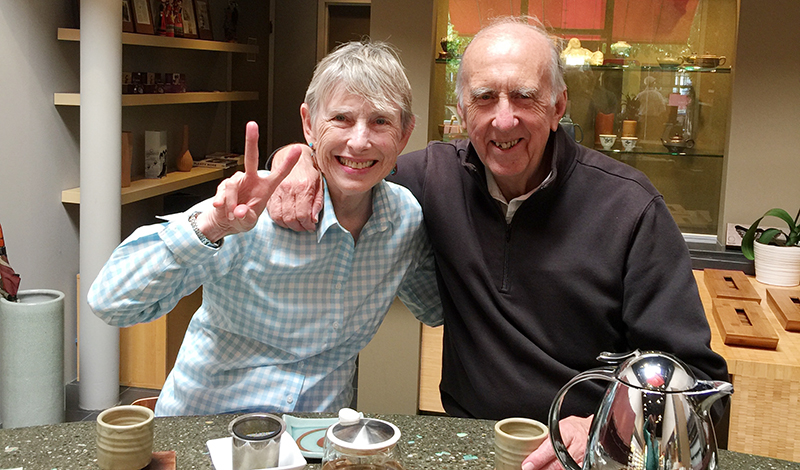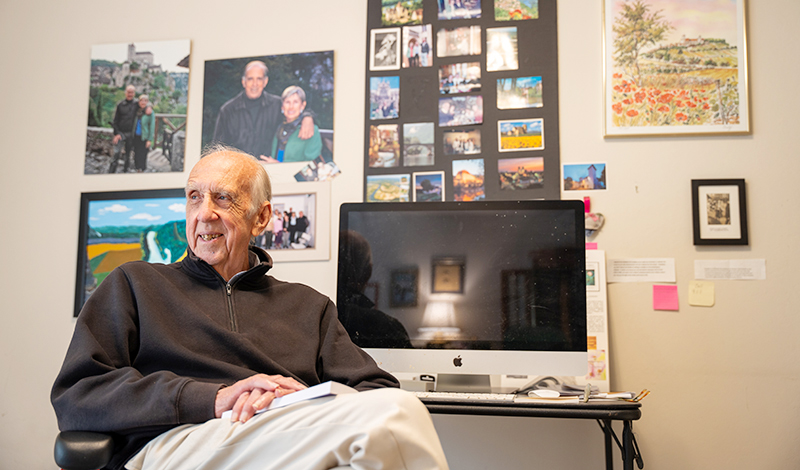by James Hilgendorf
El Cerrito, Calif.
Who knows what draws two people together and keeps them that way. We were apples and oranges, Elizabeth and I; polar opposites; almost nothing in common. I worked odd jobs to sustain a cloistered lifestyle, holed up, a writer and his typewriter. Elizabeth was someone who fell asleep as soon as she picked up a book. We were both hippies, though, that’s one thing we shared, love beads and all.
We met in 1971 in a boarding house in Boulder, Colorado, and were drawn to each other. Rolling stones, she and I, that’s for sure, no real direction. But when we met, it set us down a different road somehow, together. Whose idea it was to go to LA, to Santa Monica, I don’t remember, but we decided the year after we met and married that that’s what we would do. Within a week of arriving, I was invited to my first SGI meeting.
What struck me most from that meeting were the experiences and energy of the people there. I still remember the single mother who shared of chanting for a car and getting one. Down to earth and high-energy, these people were using Buddhism to confront real problems for real results.
As mentioned, I was a hippy, but not the sort to pick up a sign in protest of the world’s injustices, though they pained me deeply. No, my tendency—my karma—was to turn inward, withdrawing further and further into myself in search of an inner force of reformation. But that would be challenged as I began practicing with the SGI.
Ours was a fast-paced kind of Buddhist practice in the ’70s. I’m talking activities 6 1/2 days a week, hitting the streets to share Buddhism and the World Tribune. It sounds a little crazy now, and it was—all chanting and propagation, very little study—but it was just what I needed at the time, a total 180 from the monastic life I had been drawn to. I got a good, steady job and started making money. I wrote less in those days but exposed myself to life and people as I never had before, and never felt so connected with both.
Love beads aside, another thing Elizabeth and I had in common was that we came from unhappy homes. In mine, my parents’ arguments sometimes came to blows. In Elizabeth’s was an unhappiness of an opposite kind, a marriage cold to the touch. Through daimoku and propagation, Elizabeth and I were challenging our intense karma.
There came a point, in 1987, when I began to feel deeply unhappy. I remember shouting to a senior in faith, “This won’t change; this feeling will never change!” and him calling out, whenever I took a breath, “It will change! Keep chanting! It will!”
I thought my unhappiness stemmed from my marriage. In fact, its roots spanned lifetimes. Sticking close to us over the next six months, this senior in faith helped us maintain a strong daily practice. One step at a time, Elizabeth and I made our way over what had seemed an insurmountable ridge whose summit saw the blossoming of our relationship. Both of us felt we had confronted and overcome not only the marital karma that was ours and ours alone, but also that which we’d inherited from both our parents.
In me, another unlikely feeling was taking shape, a desire to do something my former monkish self would have never considered: filmmaking. Standing beside my brother at the window of our family home in Indiana, the Christmas of 1991, watching the snow falling over the land, I turned to him and said, “Let’s make a film about Indiana.” Over the next several years, he and I produced 12 travel films and one documentary. Beyond our wildest expectations, these came to be viewed by millions of people around the world.
Without a regular Buddhist practice, without engaging so much in propagation, I’d have never developed the filmmaker’s requisite drive to connect with life and people. But as it happens, sharing Buddhism with others has always been our strong suit, Elizabeth’s and mine. Wherever we’ve gone we’ve made it our mission to spice things up a little, shakubuku-wise. Topping the list of married life’s greatest pleasures has been a three-way tie between cooking with Elizabeth, having tea and chocolates with Elizabeth, and doing shakubuku with Elizabeth.
In recent years, our spot of choice was El Cerrito BART train station, where we’d strike up conversations with others on Buddhism. Even when Elizabeth was diagnosed with pancreatic cancer in 2018, even as she began rounds of intensive chemo, we’d go there as often as we could, to share Buddhism with the young people arriving and departing in waves.
I still remember after my father died, my mother telling me, “You’ll never know what it’s like until you go through it yourself.” Her words were with me in the weeks and months after Elizabeth passed away in December 2020.

What got me through her loss were Nichiren Daishonin’s writings and the guidance of Ikeda Sensei. I read from them constantly. This was amid a global pandemic, intense political strife and enormous suffering in America. In the physical isolation of that time, I turned again to writing, wanting to convey my feelings for Elizabeth and a feeling of hope and courage to others across the country. Even in the face of death, I wanted to express my unwavering belief in the yet-unfulfilled dream of America. Based on this desire, I put together a book and began promoting it widely through thousands of individual email exchanges, in which I also briefly discussed the SGI and Nam-myoho-renge-kyo.
Recently, I’ve begun conversing with young people on my daily walks, introducing them to this practice and, around their availability, coordinating pop-up intro meetings in my district. Through these efforts, I met a young man who has started chanting and attending meetings and a young woman whom I connected to her district women’s leaders.
With each young person I’ve spoken to about Nam-myoho-renge-kyo, I feel that I am drawing ever closer to Elizabeth, that she and I are still advancing with a shared vow, a shared mission, to spread Buddhism toward the dawn of a new America. Heart to heart, we’re advancing together, forever.
You are reading {{ meterCount }} of {{ meterMax }} free premium articles

